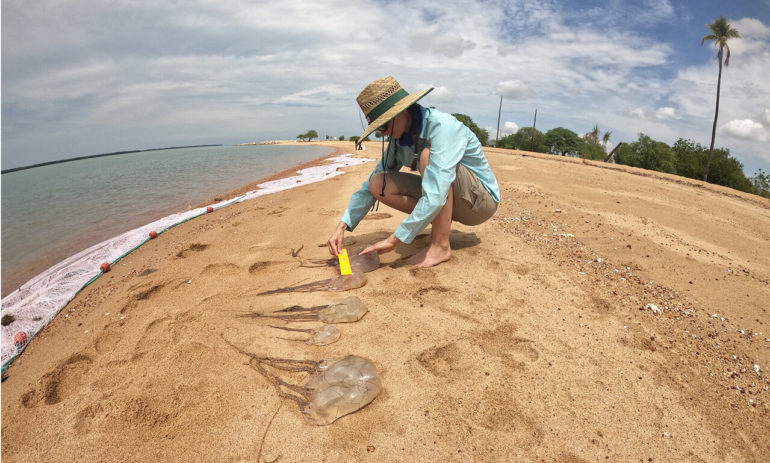The research, published today in the journal PLOS One, focused on Chironex fleckeri—a large jellyfish capable of killing a human in under three minutes and considered the most venomous animal in the world.
“Chironex fleckeri is found in waters off northern Australia from October to May, when its liking for shallow, calm, coastal waters can put it on a collision course with swimmers,” said Ph.D. candidate and project lead Olivia Rowley.
“Drone surveillance could help make our beaches safer, and reduce our reliance on time-consuming drag netting by life savers.”
Ms Rowley and colleagues from the Australian Institute of Tropical Health and Medicine set out to establish the reliability of lower-cost domestic drones in detecting these large, near-transparent jellyfish.
“The attraction of these devices is that they are more affordable, easily transported, and easier to use,” Ms Rowley said.
“They don’t require as much training and licensing as the higher-end versions and a large number of surf lifesaving clubs, particularly in Australia, already have them in their kit for rip identification, and crocodile and shark spotting.”
The researchers tested the drones’ accuracy as jellyfish spotters in waters near Weipa on Cape York Peninsula. They deployed 70-metre nets, and then recorded drone footage before pulling in the nets and counting and measuring any jellyfish.
During the experiment the drone pilot kept records of jellyfish spotted during each flight. These records were later compared with the netted numbers, and with the accuracy achieved in a lab-based review of the footage.
The researchers confirmed that reviewing footage after the flights led to significantly high detection rates. They also quantified the effects of weather conditions such as cloud cover and wind on the drones’ success rate.
“This has huge implications. Most, if not all, beaches worldwide, from Japan to Europe and beyond, have issues with very harmful jellyfish and presently there is no way of telling if animals are there until someone gets stung,” Ms Rowley said.
“This project really highlights the capacity for drones as early warning systems. Using drones is fast, effective and cheap and helps keep those on the front line out of the water and out of harm’s way.”
The next stage of the project will see this research trialed with Surf Life Saving hubs along the Queensland coast. The trials are funded by the Australian Lions Foundation and will begin in the next month.
Invasive species of jellyfish seen off three North Carolina beaches, experts say
Provided by
James Cook University
Citation:
Using off-the-shelf drones to spot deadly jellyfish (2020, October 30)
retrieved 1 November 2020
from https://phys.org/news/2020-10-off-the-shelf-drones-deadly-jellyfish.html
This document is subject to copyright. Apart from any fair dealing for the purpose of private study or research, no
part may be reproduced without the written permission. The content is provided for information purposes only.
